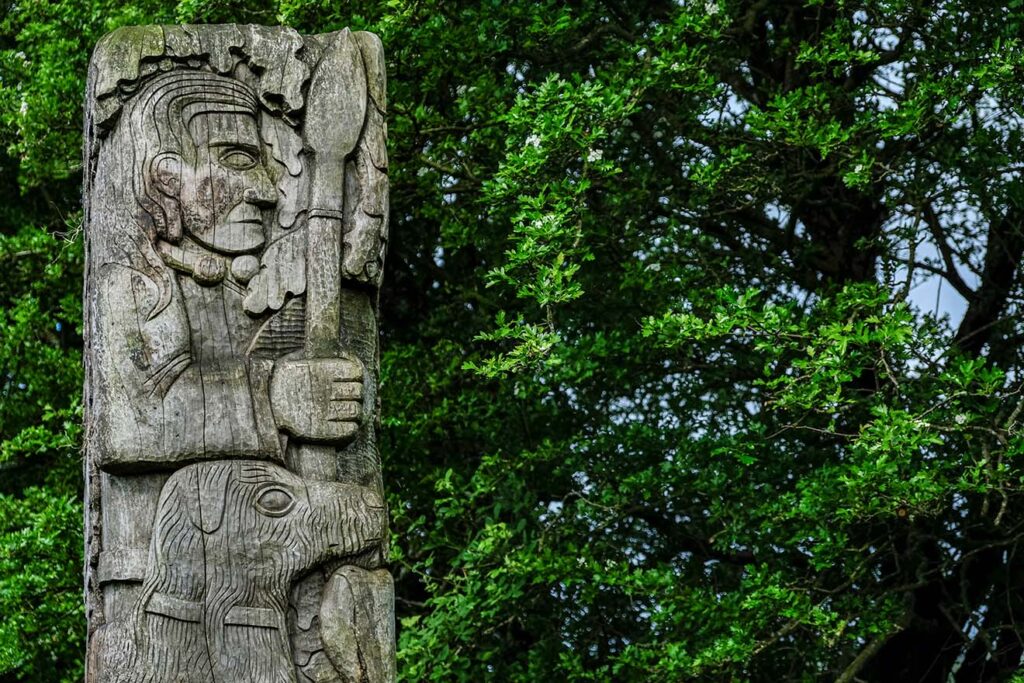Cultural Tradition & heritage

Ireland's Ancient Landscape
Droim nDamh / Drumnaph is a remnant of the ancient forest of Gleann Con Cadháin & Coill Íochtaire (Glenconkeyne and Killetra) that once covered about 80 square miles between Lough Neagh and the Sperrin Mountains. After the arrival of the earliest farmers approximately 6,000 years ago, this area evolved from dense primeval forest to become a rich tapestry of woodland, bogland, rivers and forest clearings used for grazing as well as rath settlements (like the three that are located on the reserve).
Whilst many of the vast forests of Ireland were lost in the early middle ages, this ancient forest survived into the seventeenth century thanks to some of the earliest known environmental protection legislation in Europe, the Brehon Laws. The laws were implemented to protect these ancient forests from pre-Christian times and helped to protect this landscape for almost 1,500 years until it was exhaustively exploited during the seventeenth and eighteenth centuries. We are very fortunate to have a microcosm of this once dominant ecosystem that has miraculously survived until the present day.
The richness of this heritage lies in the diversity of habitats: ancient woodland, semi-natural woodland, hedgerow habitats, bogland, fenland, ancient grazing land and over a mile of an important salmon-spawning river containing fresh-water mussels. These habitats all survive in isolation in the wider landscape, but very few if any areas exist where these habitats are so closely inter-related and inter-linked. This allows our reserve to support a much more complex and interrelated ecosystem than exists in today’s wider landscape. In this sense the reserve effectively acts a repository of this complex interconnected ecosystem that could help reinstate and strengthen biodiversity in other valuable ecological ‘island’ sites in Mid Ulster and beyond.

Open a window into the landscape of our ancient past
Droim nDamh / Drumnaph opens a window into the landscape of our ancient past where forest, boglands, and wetland were once dominant habitats. It is a microcosm of Ireland’s ancient landscape and a treasure chest of biodiversity preserving a rich natural environment for future generations.
The reserve is a repository of our environmental & archaeological heritage as well as our cultural tradition and language. It connects our community with its past and in doing so builds a better and sustainable future.
"There is a rich folklore, history and oral tradition associated with Drumnaph and Gleann Con Cadháin. Droim nDamh meaning “ridge of the stag”, is the setting for an important mythological tale, which forms a valued local connection to a body of ancient European folklore heritage, the Fianna stories (that also includes the story of the Giant’s Causeway)."
Drumnaph and our cultural traditions
OUR CULTURE AND STORIES
There is a rich folklore, history and oral tradition associated with Drumnaph and Gleann Con Cadháin. Droim nDamh meaning “ridge of the stag”, is the setting for an important mythological tale, which forms a valued local connection to a body of ancient European folklore heritage, the Fianna stories (that also includes the story of the Giant’s Causeway). These tales contribute an enlightening and intriguing dimension to the local heritage. Through our community events we celebrate these stories and bring them to life for all generations to enjoy.
Historically, the reserve was traversed with a network of pathways and local people have used it over the centuries to get to school, to reach the local town and to visit neighbouring townlands. The reserve holds a very special place in local oral tradition and heritage including tales of an itinerant scholar, handyman and labourer called McCartney who, in the 19th Century was said to spend time under one of the large oak trees in the woods that is still known as McCartney’s Oak.
Irish Folklore & Mythology
Our ancient folklore, Brehon law scripts, recorded historical events and oral tradition provide a rich narrative of Drumnaph and help to animate and communicate the important heritage themes of this project.
Carntogher Community Association is actively working to strengthen the ecosystems in the reserve and to encourage local landowners to get involved in enhancing the biodiversity in the surrounding areas by promoting conservation knowledge and information about the range of incentives that are available to landowners to promote biodiversity on their lands.
The Drumnaph Fianna story
Droim nDamh meaning the “ridge of the stag” – relates to local folklore that has survived in the oral tradition and which was written down in the early 19th century as part of the ‘O’Donnovan’ Ordinance Survey Memoirs. The Folk tale is connected to the Fianna stories which have been extensively recorded throughout Ireland, Scotland and the Isle of Mann and which relate to the exploits of Fionn Mac Cumhaill.
The Drumnaph story is probably a remnant of a Fianna tale. Indeed, there are other Fianna story remnants and placenames locally, for example there is a separate local story associated with the “Suí Fionn” hill which overlooks the site which may be a disjointed part of the same story.
In the Drumnaph story, Fionn was hunting within the area with his dog Bran. During the hunt Bran raised a Damh or Stag which quickly vanished underground whereupon Bran immediately started digging to unearth the stag. Unfortunately, despite his frantic digging, Bran was unable to uncover the stag and the hole which Bran had formed quickly filled with water, drowning Bran and forming Lough Bran. It is said that the shape of the stag can be seen in the ridge on the reserve which became known as Droim nDamh and the low hill adjacent to Lough Bran, formed by Bran’s digging is known as Mullach Bhrain (Bran’s hillock).

